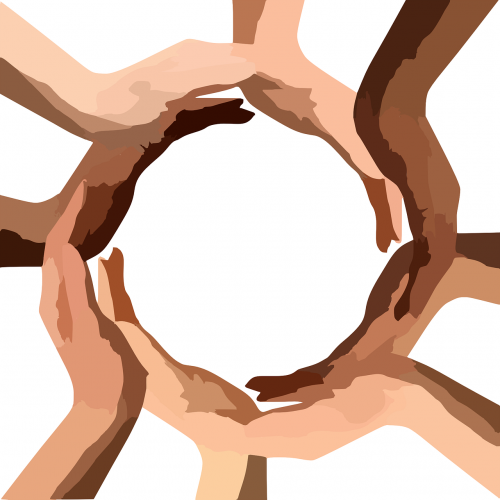As a social psychologist, Dr. Mary Inman, professor of psychology, prioritizes learning about people’s basic motivations, environmental influences on behaviors, and why and how people use stereotypes. As a Christ-follower, she seeks to understand and address social issues for the sake of justice. Her recent research on racial harassment and discrimination in the workplace addresses both of those professional and personal life goals.

Along with her colleague, Dr. Phanikiran Radhakrishnan of the University of Toronto, and Hope student Kayla Liggett ’20, Inman co-wrote the paper “The Socialization-Stressor Model of Racial Harassment” which will be published in an upcoming research book, Diversity and Inclusion in Organizations.
“The workplace ought to be a place where people want to come to work,” she says. “Kindness and respect can prevent hostilities and some workplace violence. All this informed our socialization-stressor model of workplace racial harassment and discrimination.”
What exactly is a socialization-stressor model of workplace racism? Why does it matter? Learn more in this Q-and-A with Dr. Inman.
—
How did you become involved in this research with Dr. Radhakrishnan?
Phani and I met at a psychology conference held in Texas. She was looking at workers’ experiences and outcomes of workplace racism. I was examining how people decide when an event is classified as racism. We both had an interest in misunderstandings and tension in the workplace. It was a natural fit. Hope student, Kayla Liggett, came aboard with us and is a co-author on our paper, too. I value her contributions.
Why is this research important to do?
People spend a third or so of their adult lives at work. Some employees stay longer with their “work family” more than with their spouses. Understanding the causes, dynamics, and solutions of racial and other identity-related tensions at work is critical. Knowing the causes can help researchers and human resource leaders identify and test possible solutions to create harmony at work. Workers do not need the added stress of prejudice and discrimination. All workers have value. All workers need to be heard, respected, and affirmed, especially while working through difficult company decisions like mergers or layoffs. This will help the employees’ mental health and help the company. Racial tensions hurt the company’s climate, reputation, stock, and finances when lawsuits arise.
I am interested in understanding the daily racialized events and related work outcomes. Our research is reliably showing that racial harassment and discrimination experiences are related to negative emotions, dissatisfaction with coworkers, poor health symptoms, and intentions to quit. Companies and employees need to be informed.
What is the socialization-stressor model of workplace racism?
We reviewed several research articles in psychology, sociology, and business to understand what causes stereotypes to be promoted in organizations and what the trickle-down effects are. Our model states that stereotypes are socialized beliefs that people bring to the company. Racial stereotypes can affect work behaviors such as racial harassment and racial discrimination. The model states that people pay attention to the racial composition of the company, the perpetrator’s race, and the target’s race when deciding if racially charged comments and actions reflect racism. The model states that both harassment and discrimination are social stressors that can drain energy, joy, and engagement when at work.
And why did you create the model for this research?
We developed this model because it logically fits with the stereotyping social psychology research and the discrimination-as-stressor research. Our model focuses on the distinction between harassment and discrimination as two social stressors at work that are related and yet could have different outcomes.
Our research is reliably showing that racial harassment and discrimination experiences are related to negative emotions, dissatisfaction with coworkers, poor health symptoms, and intentions to quit. Companies and employees need to be informed.
How are racial discrimination and racial harassment distinct?
Both are behaviors rooted in racial stereotyping. Racial harassment is the interpersonal behaviors of racially based comments, jokes, invalidation, and slurs. It is also excluding people from work social events based on race.
Racial discrimination is hindering one’s employability or advancement. Behaviors include racially biased practices in hiring, pay, and promotion. We also focused on more subtle behaviors such as withholding key work information, resources, training, good equipment, assignments, and public recognition due to one’s race. Discriminatory policies and procedures can be affected, reflecting institutional racism. So, pay inequities can happen at hiring and can re-occur when career-progressing activities favor one race. Companies should monitor their career-progressing practices, or they can lose talented workers.

How do each result in different discriminatory outcomes in an organization? Or, are their outcomes similar?
Workers have relationships with people and with the company — which produces one difference. Our prior work showed that workers compartmentalize their negative experiences at work. Dissatisfaction with supervisors was better predicted by discrimination than by harassment. The boss has input on the allocation of rewards and punishments. In contrast, harassment can come from anyone at work. Harassment, not discrimination, was more consistently related to dissatisfaction with coworkers.
The stress responses are similar for racial harassment discrimination but stronger feelings occur when employees reported experiencing both harassment and discrimination.
Our current work examined whether the stress responses are heightened by racial discrimination beyond that already felt when experiencing racial harassment. The answer seems to be yes. We’ve identified two kinds of discrimination — denial of opportunities and receiving negative treatment, like poor quality equipment— and are seeing that these are not equally toxic.
Still, a common theme in our research is that workers reported others are not sharing vital work information and that they lack the opportunities for advancement — for example, training — compared to other racial groups.
How can people “unlearn” previous socialization that might lead to racism at work?
- Diversity training efforts to raise cultural awareness of racial biases has some research support. The training involves many elements such as working firsthand with a person who violates the racial stereotype — for example, a Black hero who saves a White person from danger or failure — as well as getting to know and listen to the other person’s story, and mindful techniques such as watching one’s assumptions and stereotyping.
- Once one is aware of any implicit racial preference one has, research shows that having an internal goal to NOT be prejudiced is critical. One can internally yell, “STOP,” when racial stereotypes are activated to break the automatic racial link. Like developing a new habit, research has shown that practiced efforts to stop harassing, such as laughing at ethnic jokes, changed behavior.


